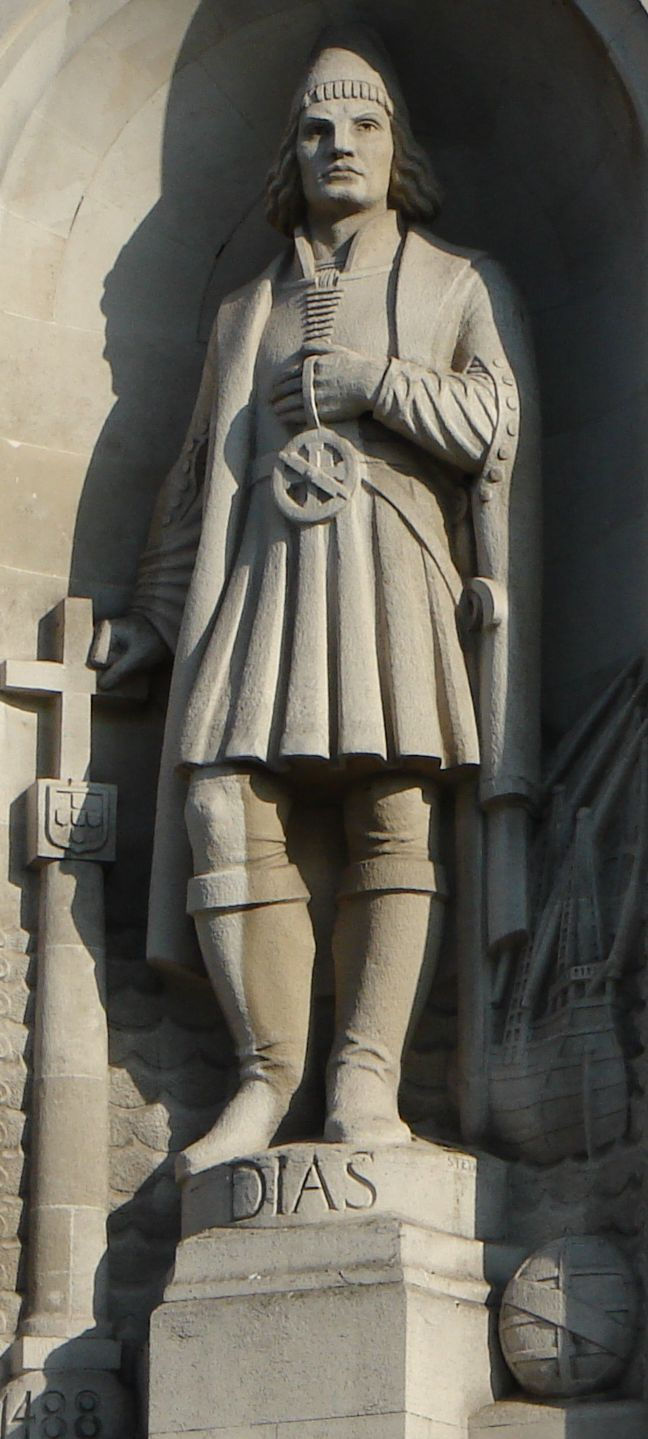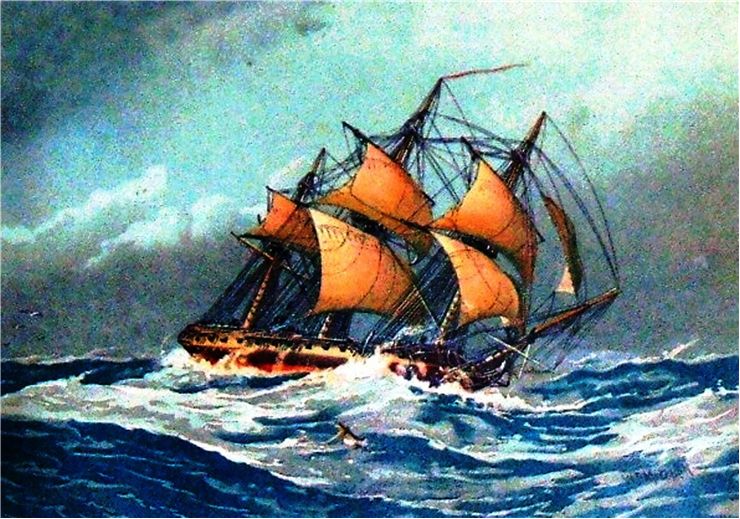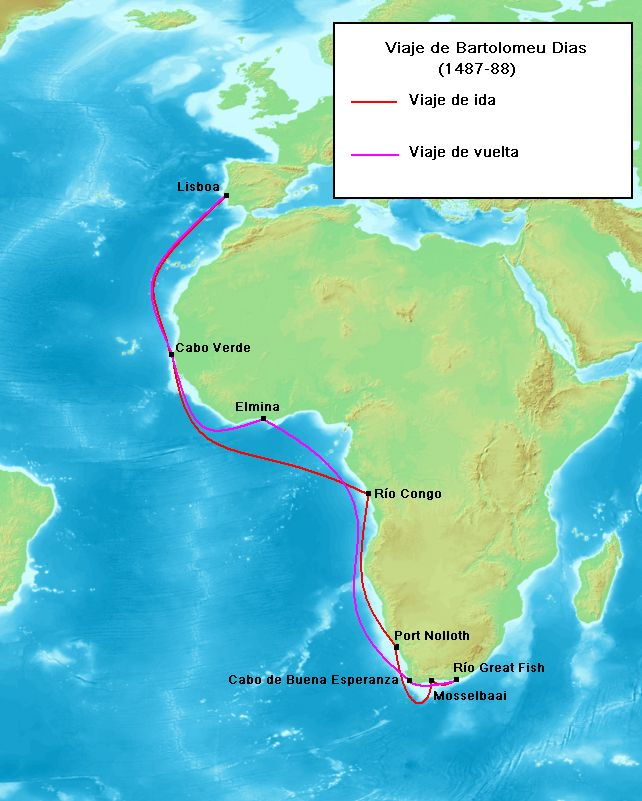Bartolomeu Dias Biography
Bartolomeu Dias (c. 1450 – 29 May 1500) was a famous Portuguese explorer and a nobleman of the Portuguese royal household. During the early period of the European naval expansion across the Atlantic in the late 15th century, he managed to sail to, discover and chart the southernmost tip of Africa in 1488, becoming the first European mariner that opened doors for the naval expansion of European interests to Asia. In the short term, Dias' discovery provided the Portuguese with the naval route to the trade-rich regions of India and China (which have become inaccessible by land trade routes due to the Ottoman Empire's conquest of the Byzantine Empire, a decrease of Silk Road security and increased taxes). Still, in the long term, it also enabled Portuguese and Europeans to permanently colonize parts of Asia and establish a long-term presence in that part of the world.
Bartolomeu Dias' discovery also provided an important push for other explorers, who quickly petitioned for the funding of many other exploratory missions that aimed to either find new routes to India or discover new lands that European powers could claim. Bartolomeu Dias was personally involved in planning several other explorers' missions (most notably Vasco da Gama and Pedro Álvares Cabral), and his exploits directly fueled Christopher Columbus' petitions to secure a fleet that would sail straight west across the Atlantic and discover Americas.
Bartolomeu Dias – Early Life
The early life of Bartolomeu Dias was not properly recorded in history, leaving large gaps in information that have remained undiscovered to this day. Little is known of his parents, and almost nothing is known about his birth, early life, and years during which he learned the knowledge of sea navigation. His original name was Bartolomeu Dias de Novais, but he is often Anglicized as Bartholomew Diaz.
He was born around 1450 near Lisbon, Portugal, as a child in a noble family and has possibly received a good education.
Little is known of the early life of Bartolomeu Dias, including where and when he learned to sail and command ships.
The first time the Bartolomeu Dias appeared in historical records was in 1486 when he was described as a superintendent of the royal warehouses and a member of the court of João II, king of Portugal (1455-1495). He was mentioned to be a sailing master and navigator of a warship São Cristóvão (Saint Christopher). Still, previous information about his life on the sea was limited to a brief mention that he was a part of the 1481 trip undertaken by the Portugal nobleman Diogo de Azambuja that reached all the way up to the Gold Coast of Africa.
Fueled by the wishes of Prince Henry, many Portuguese expeditions tried to explore the western coast of Africa, seeking the naval route to India. However, all those expeditions were unsuccessful, enabling many naval captains to claim fame by posting their royal stone pillars (padrões) as south as possible, claiming the newfound lands to the Portugal crown. The most successful navigator of that time was Diogo Cão, who broke several records while exploring the coast of Africa. His early death prompted King John II to send several other explorers to Africa, including young Bartolomeu Dias.
The Expedition
On October 10, 1486, 36-year-old Bartolomeu Dias officially became the leader of the mission with a primary goal to finding a naval route to India, and with a secondary goal of finding the lands ruled by Prester John, a Christian priest that King John II believed was stilling living somewhere on the unknown coasts of Africa. After ten months of preparation, his journey began.
Principal Voyage
Bartolomeu Dias' fleet consisted from three ships – his flagship man-o-war São Cristóvão (Saint Christopher), large caravel São Pantaleão (commanded by one of the Dias' associates João Infante and piloted by Álvaro Martins), and a third support vessel captained by Dias' brother Pêro Dias that carried a bulk of the expedition's supplies.
Dias' famous voyage to the southernmost tip of Africa and back lasted for 16 long months.
Three ships set their sails on August 1487 from Lisbon, Portugal. They immediately sailed down beside the African coast, slowly visiting markers set by Diogo Cão and reaching Walvis Bay, Namibia, on December 8. By the end of the month, this small fleet managed to reach up to Elizabeth Bay, but storms hit western Africa in the early days of 1488. Fearing for his ships, Dias ordered a course that would put him away from the coast and experiencing a full force of the storm, and the entire fleet was pushed more toward the south. Wanting to return to the land quickly, he set his course toward the north, and on February 3, 1488, he finally reached Mossel Bay, South Africa. This made him a first European who have successfully sailed over the southern tip of Africa.
Dias explored the region for several days, encountering natives that attacked him and continued sailing slowly across the eastern coast of Africa. He reached Algoa Bay on March 12 and erected a large stone cross, claiming these lands for the crown of Portugal.
While Dias wanted to push to India in a single journey, his crew expressed the need to return. Feeling the need for resupply, the entire fleet finally turned their sails and started a return trip home. During this return trip, Dias located the southernmost point of Africa in May of 1488, naming it the " Cape of Storms. " Later, King John II of Portugal renamed it into the Cape of Good Hope (Cabo da Boa Esperança) due to its significance.
Contemporary historians have also recorded that Dias had some help on this journey. He cast off from Portugal carrying with him six Africans who he dropped off at various points, including two who were left off on the coast of Angra do Salto (probably modern-day Angola). He also left there 9 of his men that guarded a portion of his supplies. Bartolomeu Dias also possessed a large amount of navigational intelligence from previous explorers, including their navigational records and even a 1460 map obtained in Venice that showcased the Indian Ocean being placed directly beside an unexplored eastern coast Africa.
After 15 months on the sea and over 16 thousand miles of travel (and after recovering only three of his nine men in Angra do Salto), Bartolomeu Dias and his fleet returned to Lisbon, Portugal in December 1488, where they were all welcomed as heroes.
Subsequent Voyages
The triumphant return of Bartolomeu Dias from the southernmost tip of Africa did not push the Portuguese government into immediate action. Instead, they entered into 10-year long hiatus from funding new exploratory fleets, possibly because they felt the need to gather more information about the location of India. Historians discovered that Portugal's crown received valuable information from their explorer and diplomat Pêro da Covilhã during that time. Between 1487 and 1490, he traveled via the land route to south Saudi Arabia and then taken the ship to India. Navigational information from his trip provided valuable clues for the upcoming planned trip of Vasco De Gama.
Instead of being tasked to try to reach India personally, the Portuguese crown commissioned Dias to help Vasco da Gamma.
Armed with that knowledge, the Portuguese crown commissioned Bartolomeu Dias to help create the new fleet that would attempt to sail to India directly. He was involved in constructing the Vasco De Gama's flagship São Gabriel (a large 25.7-meter-long Carrack that carried 60 people and 20 guns), and its sister ship São Rafael that Paulo da Gama captioned.
When Vasco De Gama cast his sails on his legendary journey, Bartolomeu Dias was actually on board his ship. However, he accompanied him only on the first leg of his voyage, exiting at Cape Verde Islands.
In 1500, Dias captained one of the ships that were part of the large second Indian expedition that Pedro Álvares Cabral led. This fleet of 13 ships first sailed across the Atlantic to Brazil and then turning toward Africa and India. Upon reaching the Cape of Good Hope, on 29 May 1500, the fleet encountered a storm that destroyed four ships, including the one that Dias captained.
The resting place of the Bartolomeu Dias of the coast of South Africa was never found. Modern researchers and sea divers pinpointed the shipwreck of the Portuguese ships from that period (confirmed by historical coins and items). Still, historians agreed that this was not the exact ship that carried Dias.
Personal Life
Before his untimely death at sea, Bartolomeu Dias married and had two sons. His first son was Simão Dias de Novais, who led a life outside of historical records, and the second was António Dias de Novais. António distinguished himself by becoming a Knight of the Order of Christ.
The grandson of Bartolomeu Dias, Paulo Dias de Novais, was remembered as the Portuguese colonizer of Africa in the 16th century. He governed Angola and founded the first European city in Sothern, Africa (São Paulo de Luanda in 1576).
The brother of Bartolomeu Dias, Diogo Dias, was also an accomplished explorer and navigator. He was a part of the early attempt to find the route to Africa when he served as a clerk aboard the Vasco da Gama's flagship São Gabriel in 1497. Three years later, he commanded his ship in the 2nd Portuguese India Armada led by Pedro Álvares Cabral that successfully reached Brazil and India. Diogo, however, did not reach India, being forced to return home after the storm that killed his brother separated him from the rest of the fleet.
Bartolomeu Dias – Legacy
Today, Bartolomeu Dias is remembered as one of the most important explorers of the early age of European expansion. While he never discovered a naval route to India or even personally managed to sail there, he proved that Africa could be circumvented. Dias brought back to the Portugal navigational charts and information used on the following exploratory trips, including the famous journey of Vasco da Gama to India.
Discovery of the Cape of Good Hope (originally named as Cape of Storms) changed the known world map, enabling rapid expansion of European trade to Asia. The news of his discovery also directly impacted the exploits of other explorers who were trying to find a reliable trade route to India. Most notably, his news of the discovery of the Cape of Good Hope played a role in the formation of the first fleet of Christopher Columbus that was funded by the Spanish crown.
Bartolomeu Dias – Vasco da Gama's Advisor
After his influential journey, Bartolomeu Dias and the Portuguese court did not immediately jump into action and tried to rush to India. Instead, Dias settled on Guinea in West Africa, helping to establish Portugal's gold trading operation and new colonized city. The new bearer of the Portuguese crown, King Manuel I, ordered Dias to become personally involved in creating a new exploratory fleet helmed by seasoned sea navigator and explorer Vasco da Gama. A brand new fleet was assembled during that decade-long period, and new information about the overland and sea navigation route was collected from several other explorers, most notably Pêro da Covilhã.
Dias oversaw the shipbuilding process of da Gamma's flagship and personally accompanied Vasco da Gamma up to Cape Verde Islands. Dias returned to Guinea, while da Gama continued sailing beyond the Cape of Good Hope and eventually reaching India.
| Name | Bartolomeu Dias |
| Born | 1450 |
| Place of Birth | Algarve, Kingdom of Portugal |
| Died | May 29, 1500 |
| Place of Death | Cape of Good Hope |
| Category (Occupation/Profession) | Navigator and explorer |
| Nationality | Portugese |
| Known For | First European to sail around the southernmost tip of Africa |
| Children | Simão Dias de Novais, António Dias de Novais |
| Rank (Title) | Knight |
| Monuments | Dias Cross Memorial |


